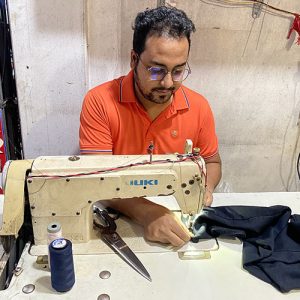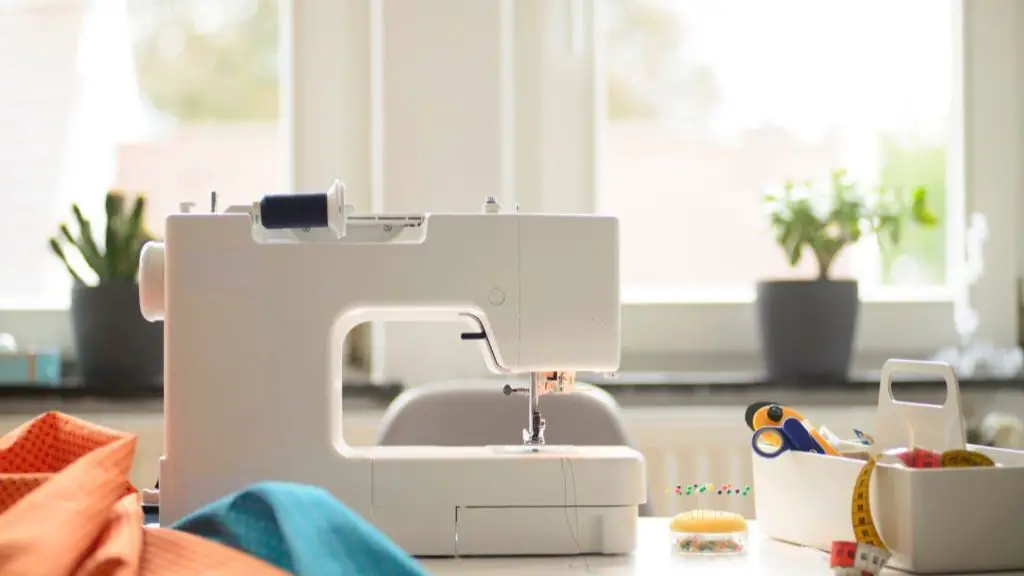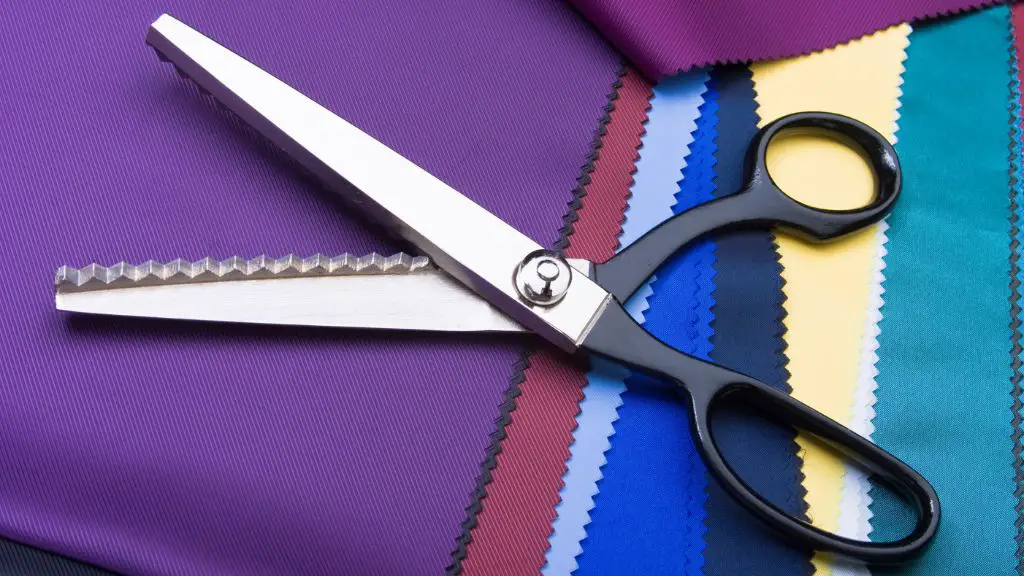Proper storage of a sewing machine makes the difference between one that lasts a lifetime and one that routinely breaks. How you store yours will ultimately determine its lifespan. So, how to store sewing machine?
This step-by-step guide will teach you to prepare your machine for storage, storing it correctly, and the importance of temperature control.
Here are a few options to consider:
- Sewing Machine Case
- Temperature-Controlled Lockers
- Storage Units
- Walk-In Wardrobes
You’ll also learn:
- The steps needed to prep a machine for short and long-term storage
- How to effectively store a sewing machine for extended periods
- Storing machines overnight
- Correctly caring for sewing machines at home
- Preparing them for moving
Things you Should Do Before Storing a Sewing Machine
Sewing machines are versatile and incredibly valuable items that need proper care to maintain them over the years. If you aren’t careful enough, you could cause serious damage to the machine. Worst still, if you have an antique or vintage machine, you could ruin any value it has.
There are a few things you need to do before you store your machine.
Clean Your Sewing Machine
You probably don’t think it’s necessary to clean the machine since it’s going to be stored away, but that’s the wrong attitude to take. You must clean the machine regularly, even when you’re putting it into storage. Whether it’s for a short or extended period, you must clean it.
Wipe down all areas you can reach, including the bobbin, bobbin case, feet, needle, base, and faceplate. Remove any dirt, oil, and dust too.
Oil the Machine
Again, you might fail to see the point of oiling the machine when it’s about to be stored, but it’s about long-term maintenance. A well-oiled machine is ready to go when you need it, whether it’s a few weeks or several months down the line.
Remember, oiling the machine helps to prevent moisture from getting into the inner workings of the machine. It also fights against rust which keeps the machine in better condition for longer. Of course, you need the right oil for your model.
Use Adequate Coverings
Your sewing machine should be wrapped carefully in soft towels, bedding, or blankets. Use lots of layers and keep the foot down on the machine before you wrap it also.
Plenty of layers give the machine lots of protection for short and long-term storage.
Take Note of Any Repairs Needed
Inspect the machine and write down any repairs or damages before you put it away. While you don’t plan to use the machine for a while, you’ll need to get it sorted later. If you have a note of what’s wrong with the machine, you can refer to it and find someone to make the repairs.
Or if you wanted to, you could get the repairs done now.
Clearly Label the Machine
Whether you’re storing the machine in a box, plastic container, or in a case, you should always label it. This prevents confusion later and it’s easily identified when you want to take it out of storage too.
Store the Machine in One Location
Constantly moving the machine from one location to the next isn’t smart. Anything can happen during transportation and little dents can become major headaches for you. It’s essential to choose one safe location and keep the machine there when it isn’t in use. Whether it’s overnight or for a year.
Replace or Remove the Needle
Sewing machine needles should be changed regularly as they easily bend, hit the bobbin case, and break. It’s important to replace the needle after every use (if you’ve been sewing for more than 6-8 hours). This keeps the machine running smoothly and prevents sewing errors.
Needles could also be removed from the machine when they’re being stored away for an extended period. It could prevent any broken needles or damage to the bobbin case should the machine be jolted during storage.
Storing a Sewing Machine for the Long haul
There are many options to store a sewing machine for an extended period. Whether you’re taking a break from sewing, moving, or just want to free up space at home.
You want to store the machine in excellent condition and find it in that state later too.
Use a Temperature-Controlled Locker
If you’re moving or putting items into storage, you should look to a temperature-controlled locker. It won’t get too hot or cold and can be easier to store sensitive items, such as sewing machines. Of course, you need to wrap the machine securely and keep it in an airtight sealable container.
It will keep it protected and prevent moisture from seeping into the machine and causing it to rust over.
Keep the Machine in a Dedicated Sewing Room or Workshop
Having extra space at home can make it easier to store sewing machines long-term. You don’t technically need to put them away in cupboards if you have a dedicated sewing room or a workshop. You could use a plastic cover to enclose the machine, base, and table for weeks at a time.
Of course, this isn’t always practical, especially if space is an issue.
Try a Non-Temperature-Controlled Storage Unit
You could also look to storage units that aren’t climate controlled. These are great for long-term storage solutions and come in all sizes too. So, if you wanted to store several machines at once, they’re a great option.
The only drawback is that they aren’t temperature-controlled. That makes storage slightly more difficult. Of course, it depends on where you live and the typical weather in the area also.
A Safe, Undisturbed Space at Home
Walk-in cupboards are ideal to store your sewing machine for the long haul. Just ensure there is no dampness in the area and aren’t near a water source. The excess moisture in the air can cause rust, so avoid these areas if you can.
Give them to a Friend to Store
Whether you’re moving or just don’t have access to storage lockers, ask a friend or family member to store the machine. If there is a dry spot on their property and it’s unlikely to be disturbed, ask them to store it. It’ll save you storage unit fees and you know it’s in good hands too.
Storing Sewing Machines for Short Periods
Storing a sewing machine for shorter periods is typically easier but still poses a few challenges. So, here are a few ideas for you to try:
Store it at Home
If you use the machine frequently, you don’t want to haul the machine in and out of a cupboard all the time. It just isn’t practical. Instead, clean and cover the sewing machine after every use and place it to the side of the room.
While this mightn’t appeal to you, it’s the more practical storage solution to consider. It’s best for those who use the machine daily and don’t have a lot of cupboard or wardrobe space. Also, if it’s a vintage machine, you don’t want to move it around so much since it’s delicate.
Ask a Friend or Family Member to Store the Machine While You Move
It’s stressful to move and you have enough on your mind without worrying about a sewing machine. Unfortunately, it can be so easily broken or lost during a move. So, ask a friend, work colleague, or family member to hold onto the machine during the move.
It’s only for a few days and there are no storage fees to worry about. Plus, you can feel more confident knowing someone you trust is keeping the machine safe.
Store the Machine Properly
Whether you’re storing the machine at home, with a friend, or in a storage unit, it must be dry and safe. You want somewhere that doesn’t have moisture and no water sources nearby. Remember, exposed metal can rust in little time and the inner workings mightn’t function as they should.
Use a Sewing Machine Case
You need a case that’s sufficient for your machine and will protect it from dust and knocks. It’s important to get a sewing machine bag or case that fits. Some even have space for accessories which is ideal to keep everything in one location.
Storing a Sewing Machine on Its Side
A lot of people frown upon the notion of lying a sewing machine on its side for storage, but it doesn’t harm it. In most cases, it’s fine and there are no issues.
If you are moving the sewing machine, however, it’s best to move it upright. The bobbin casing could become damaged during the move, so it is easier to keep it standing in an upward position.
Storing Damaged Machines
For whatever reason, if there is damage to the machine, you may want to repair it before storing it. Of course, if you don’t have the ability or money to repair it, that’s another matter. It does, however, mean you need to store the machine even more carefully.
For instance, wrap the entire machine in bubble wrap to secure any broken features. Then layer on the towels and finally place the machine in a secured plastic container. If something were to fall on top, the container and bubble wrap should absorb most of the damage.
You could also wrap individual parts that have broken off so that they don’t move around or cause more damage to the machine.
Be Careful of Humidity
The cold doesn’t affect the machine as much as the heat. Sewing machines that are exposed to extreme heat or humidity will dry out faster.
Belts are at risk and lubricants dry quickly too. So, you need to choose an area that doesn’t get too hot in the summer.
Watch for Condensation
Condensation is a killer for machines as it can cause corrosion in and around the metal. You need to protect your machine against condensation.
Ensure the machine is properly secured before it’s stored away. This is crucial, regardless of how you store it.
Storing a Sewing Machine in Attics and Basements
You’re probably tempted to leave your machine in a basement or attic at home. Unfortunately, those areas aren’t always the best. Basements could flood and attics tend to swelter during the summer.
While you could store your machine in these areas, it’s not smart. Instead, look to a temperature-controlled area. This is best to keep the machine in the best condition for longer and prevent the gears from drying out.
If the attic is the only solution, keep it in a temperature-controlled locker or wrap it in several blankets and store it in a secured container. Or keep it on a high shelf if you’re storing the sewing machine in the basement.
Keep The Machine Out of Reach of Children
When there is little room at home, you need to double up on storage and use every space available. You could store your sewing machine in a wardrobe at home if it’s only for a short period.
Of course, if you have children, there is an added risk of them breaking the machine or hurting themselves. So, it’s necessary to keep the machine away from where children can reach it, especially younger ones.
Wrap the machine in several layers of cloth and keep it in a marked box at the back of the wardrobe. If possible, store the sewing machine on a sturdy shelf where it will be safe.
Act Fast When Leaks Occur
Pipes burst all the time and when it happens, it’s a mad dash to salvage whatever you can. Your priority is to stop the water. Next, you should clear the area of your most valuable and irreplaceable items, including your sewing machine.
It doesn’t matter how old it is or how severe the water damage is, get the machine to a dry room and examine it. If there is any moisture on the machine, dry it immediately. Soak up any standing water or moisture on the base of the machine with paper towels and a cloth.
If water has seeped into the wiring or electrics, don’t switch it on. Contact a professional and let them handle any repairs. It’s dangerous and you don’t know the scale of the problem.
Don’t Pile Boxes on Top While Storing
You’re in a hurry and throw a heavy box on top of your boxed sewing machine and don’t think about it until later. It’s easily done, but unfortunately, it spells disaster for your machine. Depending on the weight of the items above, they could cause significant damage to the sewing machine.
You should never put anything on top of your sewing machine, whether you’re storing it in a case or box.
Never Store Outside
Sheds and other outdoor buildings are great storage solutions in times of need. Unfortunately, your sewing machine mightn’t be entirely safe. Remember, these areas are exposed to the elements and that could prove too much for your machine.
A little bit of rainwater and your expensive machine could be worthless.
Store in a Clean Garage
Garages are ideal to store items you don’t use often. Depending on how insulated your garage is and its size, you could use part of it as storage.
Find a quiet, damp-free corner and store the machine.
Storing a Sewing Machine for Moving
Relocating is a stressful time, and you need to be extra cautious about how your sewing machine is stored during the journey. For instance, it can jolt around in a moving truck, especially if it hasn’t been secured properly.
Fortunately, you have several options to consider.
1. Remove the Attachments
Sometimes, it’s easier to dismantle the bulkier parts of the machine when it comes to moving it. So, if it’s possible, remove any bulky attachments and wrap the machine in several layers of soft blankets.
2. Secure the Machine in a Box
Sewing machines can be well protected even in a mover’s van. You do, however, need to secure it first.
So, wrap the machine and place it in a bubble-wrapped box. This should prevent the machine from moving while it’s on the road. Strap the box down also in the mover’s truck. It shouldn’t bounce up and down if it’s strapped in correctly.
3. Secure the Machine in its Original Box
The last solution would be to place it in the original box and keep the machine in the car with you. This should work for those who have additional space in their vehicles and can keep a closer eye on it too.
The Importance of Keeping a Sewing Machine Covered During Storage
Sewing machines are vulnerable when they’re not in use because dust and dirt can get to the gears and cause havoc. If stored properly, however, the machine can remain in excellent condition and run smoothly when it’s taken out of storage.
On the other hand, if you don’t keep the machine covered, you could expose it to moisture and cause it to break down.
Conclusion
Storing a sewing machine can be done in a variety of ways. You can store them in a cupboard or wardrobe at home for short periods. Or choose a temperature-controlled locker and units for long-term storage.
Picking the right storage method will ensure your machine remains in great condition.

I love to sew and write! I have been doing both for many years and enjoy sharing my passion with others. I have written for both online and offline publications including Amazon and Medium, and I enjoy sewing clothes, quilts, and other items.
My writing style is engaging and lively, and I have a knack for delivering complex information in a way that is easy for everyone to follow.





